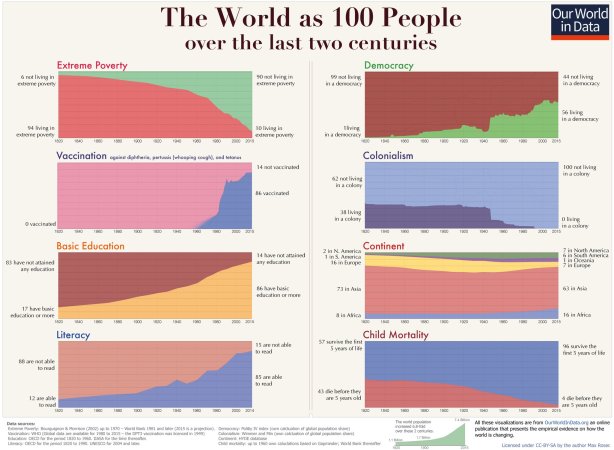From David Ruccio It should perhaps come as no surprise that, as capitalism has been called into question and socialism generated increasing interest during the past decade, capitalism’s defenders have resorted to a long historical view. Look, they say, how capitalist growth has decreased poverty and led to improvements in people’s lives around the globe. Just stick with it and all will eventually be well. That’s why, as Jason Hickel points out, the above infographic, based on sketchiest of data going back to 1820, is one of Bill Gates’s favorites. Or why Deirdre McCloskey never tires in scolding the critics of capitalism that “the Great Fact of modern life, the most surprising secular news since the domestication of plants and animals, is the rise of real income per head.” The past
Topics:
David F. Ruccio considers the following as important: Uncategorized
This could be interesting, too:
tom writes The Ukraine war and Europe’s deepening march of folly
Stavros Mavroudeas writes CfP of Marxist Macroeconomic Modelling workgroup – 18th WAPE Forum, Istanbul August 6-8, 2025
Lars Pålsson Syll writes The pretence-of-knowledge syndrome
Dean Baker writes Crypto and Donald Trump’s strategic baseball card reserve
from David Ruccio
It should perhaps come as no surprise that, as capitalism has been called into question and socialism generated increasing interest during the past decade, capitalism’s defenders have resorted to a long historical view. Look, they say, how capitalist growth has decreased poverty and led to improvements in people’s lives around the globe. Just stick with it and all will eventually be well.
That’s why, as Jason Hickel points out, the above infographic, based on sketchiest of data going back to 1820, is one of Bill Gates’s favorites. Or why Deirdre McCloskey never tires in scolding the critics of capitalism that “the Great Fact of modern life, the most surprising secular news since the domestication of plants and animals, is the rise of real income per head.”
The past two centuries of economic growth have done more to help the world’s poor than any activity by governments or charities or trade unions.
There are problem, of course, in the data—especially in basing the key series on an absurdly low poverty line of $1.90 a day.* Perhaps even more important, as Hickel explains, the numbers obscure the actual historical process:
that the world went from a situation where most of humanity had no need of money at all to one where today most of humanity struggles to survive on extremely small amounts of money. The graph casts this as a decline in poverty, but in reality what was going on was a process of dispossession that bulldozed people into the capitalist labour system, during the enclosure movements in Europe and the colonisation of the global south.
The masses people who were bulldozed into the capitalist labor system now produce and consume the immense accumulation of commodities that represents the growing wealth of nations around the world.
But even as the percentage of workers living in extreme poverty has declined, especially in recent decades, they’re falling further and further behind the tiny group at the top. That’s because the incomes generated by economic growth on a global scale have been unevenly distributed.
As the authors of the World Inequality Report 2018 have shown, while the real incomes of the bottom 50 percent of the world’s population increased (by 94 percent) from 1980 to 2016, they only captured a relatively small share (about 12 percent) of total growth during that period—while the world’s elite (whose incomes increased by 101 percent) captured more than twice that share (27 percent).**
What about those countries, such as China and India, where most of the decline in the population living in extreme poverty took place? There, the differences in total cumulative income growth was even more obscene. In China, for example, the incomes of the bottom 50 percent grew by less than 420 percent, while those of the top increased by 1920 percent. And in India, the growing gap between the bottom 50 percent and the top 1 percent is even more stark: just over 100 percent versus 857 percent.
That spectacular growth in inequality on a global scale is the part of the story the current defenders of capitalism such as Gates and McCloskey don’t want to tell. Yes, the percentage of the world’s population living in extreme poverty (at least according to conventional measures) has fallen. But that growing mass of wage-workers has been enlisted, forcibly or otherwise, in the project of producing a surplus that has been captured not by them, but by a tiny group at the top.
In other words, extreme poverty may have fallen but relative immiseration has proceeded apace—the result of a growing gap between those who have a lot and those who now have a little.
As I see it, declining poverty and growing inequality are two sides of the same historical coin of the growth of capitalism on a global scale.
*As Lant Pritchett has explained,
The exclusive reporting of international poverty based on the penurious “dollar a day” poverty line (morphed by inflation into the less lyrical “$1.90 a day” line) was a tool for “defining development down”. . .
A low bar poverty line necessarily treats both people just above the poverty line and people in considerable comfort and prosperity as “not poor” and hence necessarily creates false equivalences in which those just above and just below a poverty line were considered to be different (one “poor” and one “not poor”) but two people above the poverty line with very different incomes were treated the same (both “not poor”).
**And, for the middle 40 percent (mostly in North America and Western Europe), the growth in real incomes was much lower (only 43 percent).


